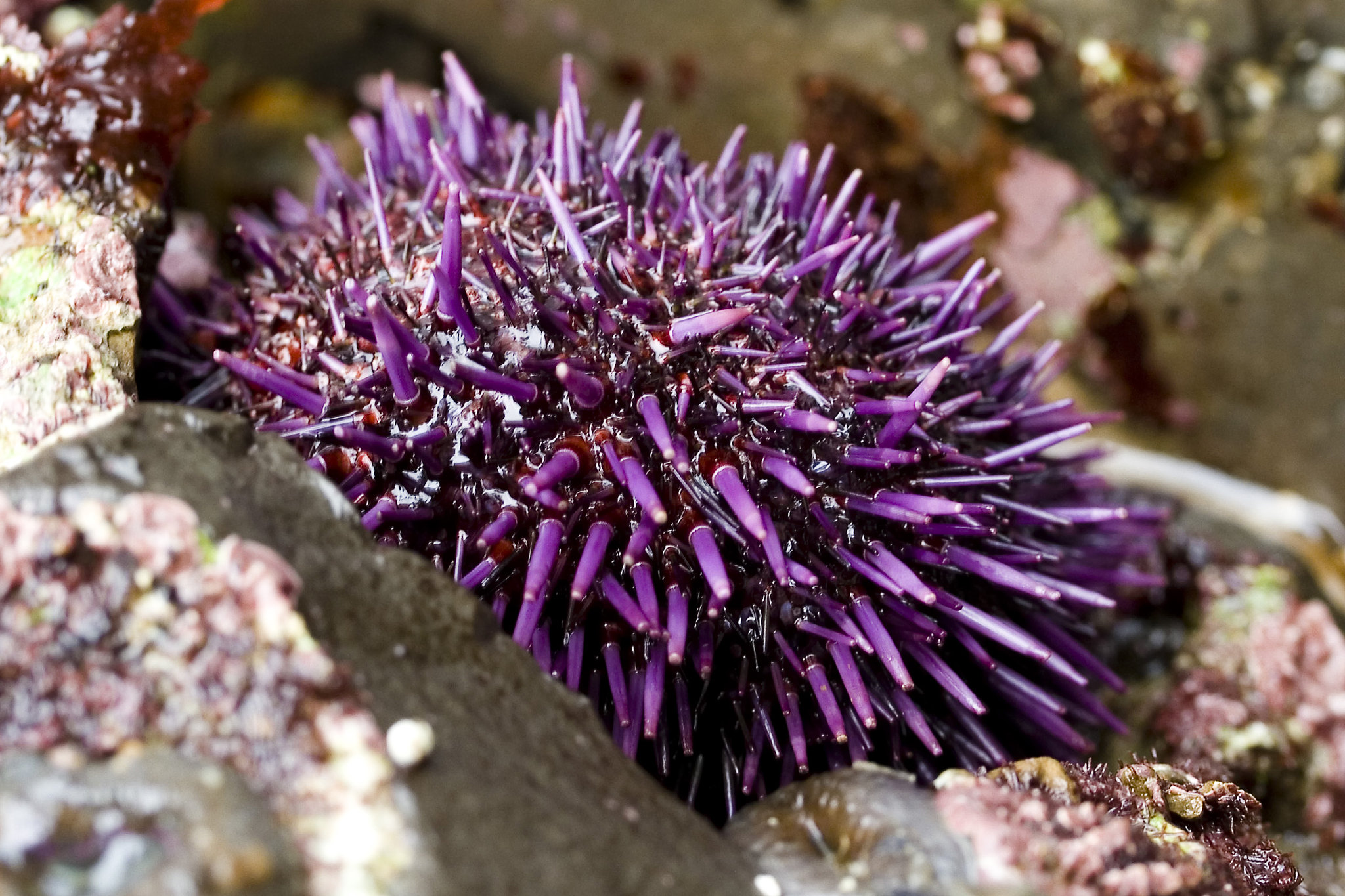Purple sea urchin (Strongylocentrotus purpuratus)
Pacific purple sea urchins are a sushi delicacy. The meat, known as "uni" in Japanese, is commonly referred to as roe, as in the eggs of a sea creature, but is actually the animal's gonads! Read more about purple sea urchins on Oceana website.

Purple sea urchins, photo by jwhallock [CC BY-NC 2.0], via flickr.com
Chromosome-length genome assembly
Download the Spur_5.0.contigs_purged_HiC.fasta.gz file containing the chromosome-length (2n=42) assembly of the purple sea urchin genome. All modifications with respect to the draft (see below) are annotated in the Spur_5.0.contigs_purged_HiC.assembly file. Some basic stats associated with the new reference, Spur_5.0.contigs_purged_HiC, are listed below. The full data release can be explored here.
Contig length (bp) | Number of contigs | Contig N50 (bp) | Longest contig (bp) |
|---|---|---|---|
752,734,574 | 1,471 | 2,909,773 | 9,384,751 |
Scaffold length (bp) | Number of scaffolds | Scaffold N50 (bp) | Longest scaffold (bp) |
|---|---|---|---|
752,926,074 | 1,088 | 32,498,873 | 56,985,613 |
Draft
The chromosome-length genome assembly is based on the draft assembly Spur_5.0.contigs (GCF_000002235.5), credited below.
Cary,G. and Hinman,V. "Improved assembly of Strongylocentrotus purpuratus genome to identify and characterize functional noncoding elements." Unpublished. https://www.ncbi.nlm.nih.gov/nuccore/AAGJ00000000.6.
Method
3D Assembly was performed using 3D-DNA pipeline (Dudchenko et al., Science, 2017). The genome was reviewed using Juicebox Assembly Tools (Dudchenko et al., bioRxiv, 2018). See Methods for more information.
Hi-C sample
The muscle sample for in situ Hi-C preparation was obtained from Christopher J. Knight (Hopkins Marine Station, Stanford University), Theresa L.U. Burnham (Coastal and Marine Institute and Department of Biology, San Diego State University, Department of Wildlife, Fish, and Conservation Biology University of California) and Kevin A. Hovel (Coastal and Marine Institute and Department of Biology, San Diego State University).
Hi-C Contact maps
Hi-C data was aligned to the draft reference using Juicer (Durand, Shamim et al., Cell Systems, 2016), and contact maps visualizing the alignments with respect to the draft and the new reference were built using 3D-DNA (Dudchenko et al., Science, 2017). The contact maps can be explored below via Juicebox.js interactive tool (Robinson et al., Cell Systems, 2018). To explore the assembly in greater detail, please download the .hic and .assembly files from the data release folder and use Juicebox Assembly Tools (Dudchenko et al., bioRxiv, 2018).
References
If you use this genome assembly in your research, please check that the conditions of use associated with the draft permit it, and acknowledge the following work.
Cary,G. and Hinman,V. "Improved assembly of Strongylocentrotus purpuratus genome to identify and characterize functional noncoding elements." Unpublished. https://www.ncbi.nlm.nih.gov/nuccore/AAGJ00000000.6.
Dudchenko, O., Batra, S.S., Omer, A.D., Nyquist, S.K., Hoeger, M., Durand, N.C., Shamim, M.S., Machol, I., Lander, E.S., Aiden, A.P., Aiden, E.L., 2017. De novo assembly of the Aedes aegypti genome using Hi-C yields chromosome-length scaffolds. Science 356, 92–95. https://doi.org/10.1126/science.aal3327.
Dudchenko, O., Shamim, M.S., Batra, S., Durand, N.C., Musial, N.T., Mostofa, R., Pham, M., Hilaire, B.G.S., Yao, W., Stamenova, E., Hoeger, M., Nyquist, S.K., Korchina, V., Pletch, K., Flanagan, J.P., Tomaszewicz, A., McAloose, D., Estrada, C.P., Novak, B.J., Omer, A.D., Aiden, E.L., 2018. The Juicebox Assembly Tools module facilitates de novo assembly of mammalian genomes with chromosome-length scaffolds for under $1000. bioRxiv 254797. https://doi.org/10.1101/254797.
Disclaimer
This is a work in progress. If you notice any discrepancies in the map or have data that confirms or contradicts the suggested reference, please email us at thednazoo@gmail.com or leave a comment on the Forum.
